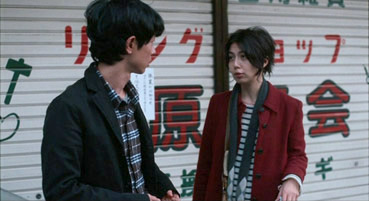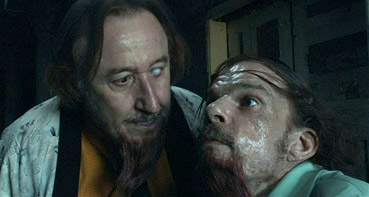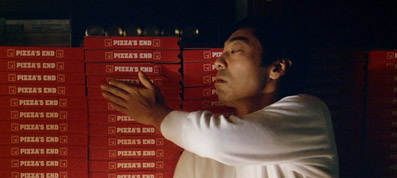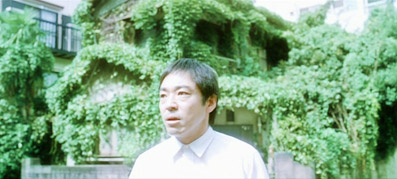|
More than once I've remarked on the difficulty of constructing a fully successful feature from a series of short films. The briefer running time rarely allows the same degree of character and story development as it's full-length cousin, and it's rarer still for the collected tales to be of consistent quality, particularly when there are different writers and directors assigned to each tale. The recently released Fear[s] of the Dark was a good example, a sound central concept that provoked responses of varying quality and even accuracy to the original brief.
Now we have Tokyo!, a three-story anthology set in Japan's capital city and uniting the not inconsiderable talents of Michel Gondry (Sunshine of a Spotless Mind), Leos Carax (Mauvais sang, Pola X) and Bong Joon-Ho (Memories of Murder, The Host). The foundations are solid enough as the location itself is awash with possibilities, and the three filmmakers have all proved themselves capable of telling interesting and offbeat stories in compelling fashion. So, can they work the same magic on the short film format as they have on their features? Well...

The first story, Interior Design, sees aspiring filmmaker Akira and his girlfriend Hiroko arriving in the city and meeting up with Hiroko's old friend Akemi, who has offered to put them up until they find a place of their own. Actually doing so proves a little tricky, with problems evident in every apartment they look at, from a dead cat on the veranda to an infestation of bugs in the floor. Hiroko has similar luck in his search for a job, her ineptness at wrapping parcels for store customers landing Akira the post in her place. One night she overhears Akemi quietly complaining about her laziness, and the next morning she starts to undergo a metamorphosis that will finally see her life gain some purpose.
In Merde (yep, that's French for 'shit'), a bedraggled and wild-eyed man climbs out of the sewers and storms through the streets assaulting citizens, then disappears back underground, prompting media speculation over his identity and origin. Curiosity mutates into horror when on his next appearance he randomly tosses live grenades into the passing crowds, killing and injuring many. When arrested he is unable to communicate with his captors, but the arrival of oddball French lawyer Maître Voland changes all that. He shares some of the man's physical character traits and appears to speak his unique language, and agrees to act as his council when he is put on trial for his life.
Shaking Tokyo focuses on an unnamed man who for ten years has not left the confines of his apartment. He is what is known as a hikikomori, a Japanese term for someone who has withdrawn from social life and lives a completely isolated existence, often in a urban setting. He refuses to make eye contact even with those who deliver his ordered meals, but when an earthquake prompts the pizza delivery girl to faint, the man becomes fascinated by her. His hopes of a second meeting are dashed, however, when he discovers that she too has become a hikikomori.

It's worth noting that the title is, in a subtle but significant way, a little misleading. It's not the place name I'm referring to – all three of the stories are set there, after all – but the exclamation mark that follows, which can't help but suggest that the city plays a more significant part in the stories than it does. Indeed, I'd go as far as to suggest that the first two could have been set in almost any major industrial city without significant alteration – only Shaking Tokyo, with it's hikikomori and earthquakes, feels wedded to this particular locale. The point is illustrated by the fact that the first segment is based on Gabrielle Bell's graphic novel Cecil and Jordan in New York, which was set in...well, you work it out.
Adapted and directed by Michel Gondry, Interior Design is certainly peppered with interesting and locale-specific detail, not least Akemi's cramped living conditions, a common problem in a city that houses something like ten per cent of the country's population. There's a degree of a fun had with Akira's ludicrous-looking art film and the response to it, while Hiroko's friendly encounter with a disgruntled car pound worker provides the segment's nicest character moment. If there's a problem it's that when the switch to metaphor comes, it does so suddenly and unsubtly, and is triggered less by what has gone before than an overheard conversation. There's no real sense that Hiroko is really lacking a purpose in life until Akemi tells her visiting boyfriend – loudly enough for Hiroko to overhear – that all her friend does is loaf around all day. The transformation that takes place is unsettlingly realised (a particularly creepy use of CG here), but the subsequent point about the importance of purpose and meaning in life is rather bluntly made, a social message delivered with a surrealist hammer.
Leos Carax's Merde likewise wears its metaphors like a Technicolor dream coat, with the self-named title character a symbol for just about anything you care to name that challenges, upsets and divides a society, a few of which are even suggested by an early news report in which the character is variously linked with Al Qaeda, a Hungarian paedophile ring, and Japan's own Aum Shinrikyo sect. This segment feels even less connected to the location than its predecessor and only gets specifically Japanese when Merde gets to court and expresses his loathing for them as a race for living too long and having eyes that look like female genitalia. Hmm. A bigger problem is French lawyer Maître Voland and the peculiar language he shares with his client, their extended first conversation proving a showcase for barnstorming over-theatricality, with actor Jean-François Balmer tearing up the scenery with a stream of wild-gestured gibberish that suggests he was encouraged to improvise and go nuts with the concept. As his client, Carax favourite Denis Lavant is almost a model of restraint by comparison. Like Gondry, Carax keeps it visually interesting, particularly in the early long tracking shot that follows Merde on his first anarchic march through the city and the split screen presentation of the trail. There are interesting throwaway moments – the cult whose chants and gestures are borrowed from Merde is a nice touch – and the whole thing plays at times like a twisted cousin of Godzilla, but there were times here when I was just itching to move on to the final segment.

Fortunately for me and for the movie, the last story is a good one. Bong Joon-ho's tale of a hikikomori who finds himself attracted to a like-thinking woman and is then separated from her by the very trait that they share is a tale that benefits initially from its simplicity, by focussing on the the daily routine of the central character (played by Teruyuki Kagawa, so good as the pride-battered husband in Tokyo Sonata) and the engagement with his mindset through his soft-spoken narration. The fantasy elements are there – this time in the shape of tattoos on the pizza girl's body that act as buttons that when pressed activate a specific emotion or wake her from unconsciousness – but they somehow feel more organic to the tone of the piece than those in the preceding segments. It certainly feels the most authentically Japanese of the three, a reflection perhaps of its cultural similarities with Bong's home country – once seen as a largely Japanese phenomenon, the hikikomori lifestyle is apparently on the rise in South Korea as well. It's also the most purposefully directed, particularly in the use of overexposure and heightened background sound to make the outside world seem as intimidating to the audience as it does to the lead character.
Opinions will and do differ, of course, and my intermittent irritation with Merde is certainly not shared by all, with a couple of reviewers even naming it as their favourite segment. It is, as such films tend to be, an interesting experiment, and opinions on where it succeeds or fails are likely to vary wildly from viewer to viewer. For me, it doesn't quite happen until the last story, which I enjoyed a great deal – the first two segments definitely have their moments, but it's Bong's deftly handled piece that is most fully deserving of that exclaimed title.
In a decision that must create headaches for projectionists, the first two stories are framed 1.85:1 and the third 2.35:1, and all three are anamorphically enhanced. Bright colours are not the order of the day on any of the segments, while sunlit exteriors are rare in the first two and generally toned down when they do appear, with exposure games played with sunlight in the third. Within these restrictions the picture quality is good rather than great. Sharpness and contrast are sound enough, but grain is visible throughout and the shadow detail is sometimes affected by the colour timing, although we can assume some of this is deliberate – the face-to-face shots of the hikikomori's first encounter with the pizza delivery girl in story 3, for example, appear to have a weaker contrast range than the shots that surround them.

The Dolby 2.0 Stereo and 5.1 surround tracks are similar in many ways, with some intermittent and largely subtle surround work on the 5.1 not providing enough of a reason to select it over the slightly beefier stereo track. This all changes with the grenade explosions and especially the earthquakes, which have serious LFE impact on the 5.1.
Appropriate to the structure, there are three separate making-of featurettes included, all of which run for a substantial length and are different enough in tone to qualify as individual pieces rather than segments of a larger documentary. All appear to have been created for a Japanese DVD release, hence the presence of Japanese captions that are subtitle translated.
Making of Gondry (30:02) is built around interviews with the director (in English) and members of the cast and crew (in Japanese with subtitles). Subjects covered include Gondry's unorthodox approach to filmmaking, which sometimes involves shooting without rehearsal and keeping the camera rolling between takes, both of which threw a cast not familiar with such methods. The director's initial involvement with the project and his thinking on the story are also briefly covered, as is working with an all-Japanese crew and the casting of the key roles, and there is a sprinkling of behind-the-scenes footage.
Making of Carax (29:34) has no interviews and instead observes the preparation for and shooting of a number of key sequences, including Merde's first walk through the city and the grenade tossing scene in Tokyo's busy Shibuya district. This is actually very interesting, particularly the rehearsal and coordination of the first long walk, and seeing that the shot was achieved by pulling the camera operator along in a wheelchair gave me a twinge of nostalgia.
Making of Bong takes this observational approach a stage further by watching the filming of a small number of the exterior scenes at the sort of length that suggests we're seeing all of the footage that was shot rather than an edited version. It's still of real interest, however, and the sight of everyone standing around ready to film while the camera team wait for the light to be just right should prompt a smile of recognition to anyone who's had to do likewise.
Also included is a Trailer (1:29), which intrigues without giving too much away.
It didn't all work for me as well as I'd hoped, but there's enough variety in the stories and their telling to provide at least partial satisfaction for most potential viewers and maybe more than that to those better tuned to what Gondry and Carax are up to. No complaints with Optimum's DVD, though, which scores well enough on picture and sound and whose interesting extra features run almost as long as the film.
|